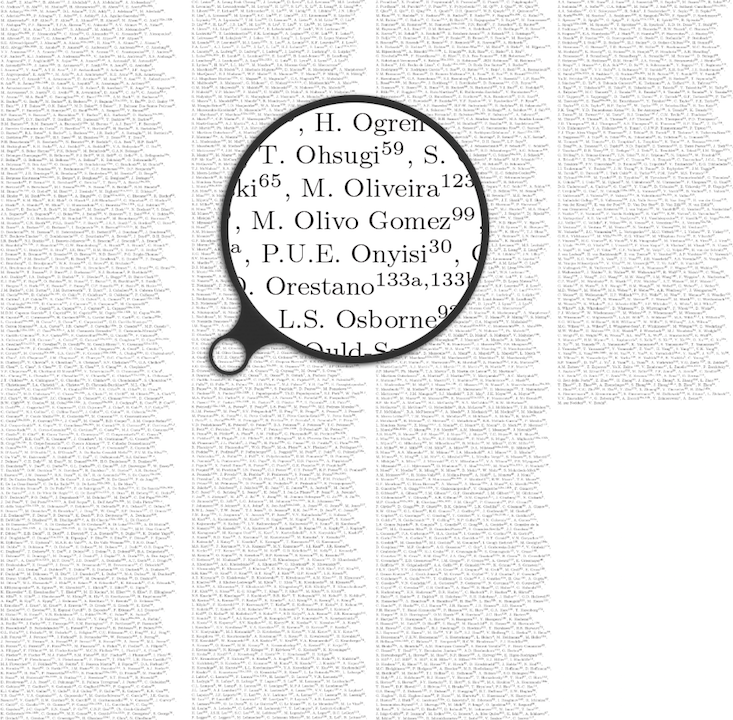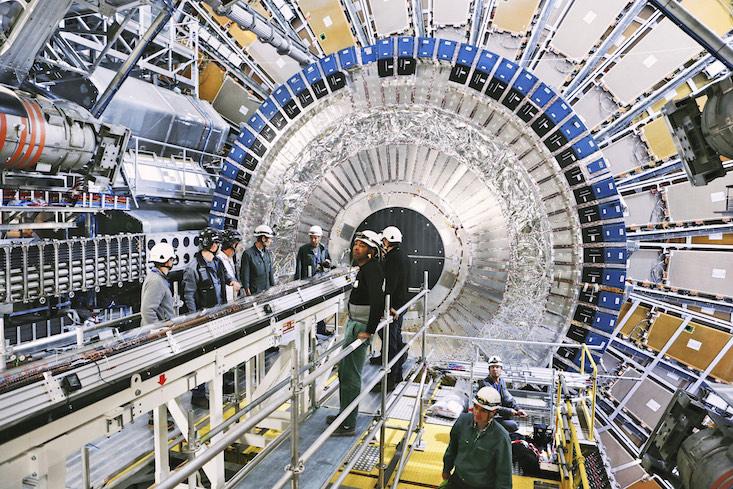To those who say that there is no room for genius in modern science because everything has been discovered, Fabiola Gianotti has a sharp reply. “No, not at all,” says the former spokesperson of the ATLAS Experiment, the largest particle detector at the Large Hadron Collider at CERN. “Until the fourth of July, 2012 we had no proof that nature allows for elementary scalar fields. So there is a lot of space for genius.”
She is referring to the discovery of the Higgs boson two years ago—potentially one of the most important advances in physics in the past half century. It is a manifestation of the eponymous field that permeates all of space, and completes the standard model of physics: a sort of baseline description for the existence and behavior of essentially everything there is.
By any standards, it is an epochal, genius achievement.
What is less clear is who, exactly, the genius is. An obvious candidate is Peter Higgs, who postulated the Higgs boson, as a consequence of the Brout-Englert-Higgs mechanism, in 1964. He was awarded the Nobel Prize in 2013 along with Francois Englert (Englert and his deceased colleague Robert Brout arrived at the same result independently). But does this mean that Higgs was a genius? Peter Jenni, one of the founders and the first “spokesperson” of the ATLAS Experiment Collaboration (one of the two experiments at CERN that discovered the Higgs particle), hesitates when I ask him the question.
“They [Higgs, Brout and Englert] didn’t think they [were working] on something as grandiose as [Einstein’s relativity],” he states cautiously. The spontaneous symmetry breaking leading to the Higgs “was a challenging question, but [Einstein] saw something new and solved a whole field. Peter Higgs would tell you, he worked a few weeks on this.”
The ability of the precocious individual physicist to suggest a new data cut or filter is restricted.
What, then, of the leaders of the experimental effort, those who directed billions of dollars in investment and thousands of physicists, engineers, and students from almost 40 countries for over three decades? Surely there must have been a genius mastermind directing this legion of workers, someone we can single out for his or her extraordinary contribution.
“No,” says Gianotti unequivocally, which is rare for a physicist, “it’s completely different. The instruments we have built are so complex that inventiveness and creativity manifests itself in the day-by-day work. There are an enormous amount of problems that require genius and creativity to be spread over time and over many people, and all at the same level.”
Scientific breakthroughs often seem to be driven by individual genius, but this perception belies the increasingly collaborative nature of modern science. Perhaps nothing captures this dichotomy better than the story of the Higgs discovery, which presents a stark contrast between the fame awarded to a few on the one hand, and the institutionalized anonymity of the experiments that made the discovery possible on the other.
An aversion to the notion of exceptional individuals is deeply rooted within the ATLAS collaboration, a part of its DNA. Almost all decisions in the collaboration are approved by representative groups, such as the Institute Board, the Collaboration Board, and a plethora of committees and task forces. Consensus is the name of the game. Even the effective CEO, a role Gianotti occupied from 2009 to 2013, is named the “Spokesperson.” She spoke for the collaboration, but did not command it.
Collectivity is crucial to ATLAS in part because it’s important to avoid paying attention to star personalities, so that the masses of physicists in the collaboration each feel they own the research in some way. Almost 3,000 people qualify as authors on the key physics papers ATLAS produces, and the author list can take almost as many pages as the paper itself.1

On a more functional level, this collectivity also makes it easier to guard against bias in interpreting the data. “Almost everything we do is meant to reduce potential bias in the analysis,” asserts Kerstin Tackmann, a member of the Higgs to Gamma Gamma analysis group during the time of the Higgs discovery, and recent recipient of the Young Scientist Prize in Particle Physics. Like many physicists, Tackmann verges on the shy, and speaks with many qualifications. But she becomes more forceful when conveying the importance of eliminating bias.
“We don’t work with real data until the very last step,” she explains. After the analysis tools—algorithms and software, essentially—are defined, they are applied to real data, a process known as the unblinding. “Once we look at the real data,” says Tackmann, “we’re not allowed to change the analysis anymore.” To do so might inadvertently create bias, by tempting the physicists to tune their analysis tools toward what they hope to see, in the worst cases actually creating results that don’t exist. The ability of the precocious individual physicist to suggest a new data cut or filter is restricted by this procedure: He or she wouldn’t even see real data until late in the game, and every analysis is vetted independently by multiple other scientists.
Most people in the collaboration work directly “for” someone who is in no way related to their home institute, which actually writes their paycheck.
This collective discipline is one way that ATLAS tames the complexity of the data it produces, which in raw form is voluminous enough to fill a stack of DVDs that reaches from the earth to the moon and back again, 10 times every year. The data must be reconstructed into something that approximates an image of individual collisions in time and space, much like the processing required for raw output from a digital camera.
But the identification of particles from collisions has become astoundingly more complex since the days of “scanning girls” and bubble chamber negatives, where actual humans sat over enlarged images of collisions and identified the lines and spirals as different particles. Experimentalists today need to have expert knowledge of the internal functioning of the different detector subsystems: pixel detector, silicon strip tracker, transition radiation tracker, muon system, and calorimeters, both hadronic and electromagnetic. Adjustments made to each subsystem’s electronics, such as gain or threshold settings, might cause the absence or inclusion of what looks like real data but isn’t. Understanding what might cause false or absent signals, and how they can be accounted for, is the most challenging and creative part of the process. “Some people are really clever and very good at this,” says Tackmann.
The process isn’t static, either. As time goes on, the detector changes from age and radiation damage. In the end the process of perfecting the detector’s software is never-ending, and the human requirements are enormous: roughly 100 physicists were involved in the analysis of a single and relatively straightforward particle signature, the decay of the Higgs into two Gamma particles. The overall Higgs analysis was performed by a team of more than 600 physicists.
The depth and breadth of this effort transform the act of discovery into something anonymous and distributed—and this anonymity has been institutionalized in ATLAS culture. Marumi Kado, a young physicist with tousled hair and a quiet zen-like speech that borders on a whisper, was one of the conveners of the “combined analysis” group that was responsible for finally reaching the level of statistical significance required to confirm the Higgs discovery. But, typically for ATLAS, he downplays the importance of the statistical analysis—the last step—in light of the complexity of what came before. “The final analysis was actually quite simple,” he says. “Most of the [success] lay in how you built the detector, how well you calibrated it, and how well it was designed from the very beginning. All of this took 25 years.”

The deeply collaborative work model within ATLAS meant that it wasn’t enough for it to innovate in physics and engineering—it also needed to innovate its management style and corporate culture. Donald Marchand, a professor of strategy execution and information management at IMD Business School in Lausanne, describes ATLAS as following a collaborative mode of working that flies in the face of standard “waterfall”—or top down—management theory.
Marchand conducted a case study on ATLAS during the mid-2000s, finding that the ATLAS management led with little or no formal authority.2 Most people in the collaboration work directly “for” someone who is in no way related to their home institute, which actually writes their paycheck. For example, during the construction phase, the project leader of the ATLAS pixel detector, one of its most data-intensive components, worked for a U.S. laboratory in California. His direct subordinate, the project engineer, worked for an institute in Italy. Even though he was managing a critical role in the production process, the project leader had no power to promote, discipline, or even formally review the project engineer’s performance. His only recourse was discussion, negotiation, and compromise. ATLAS members are more likely to feel that they work with someone, rather than for them.
Similarly, funding came from institutes in different countries through “memorandums of understanding” rather than formal contracts. The collaboration’s spokesperson and other top managers were required to follow a politic of stewardship, looking after the collaboration rather than directing it. If collaboration members were alienated, that could mean the loss of the financial and human capital they were investing. Managers at all levels needed to find non-traditional ways to provide feedback, incentives, and discipline to their subordinates.
One famous member of the collaboration is looked upon dubiously by many, who see him as drawing too much attention to himself.
The coffee chat was one way to do this, and became the predominant way to conduct the little daily negotiations that kept the collaboration running. Today there are cafés stationed all around CERN, and they are full from morning to evening with people having informal meetings. Many physicists can be seen camped out in the cafeteria for hours at a time, working on their laptops between appointments. ATLAS management also created “a safe harbor, a culture within the organization that allows [employees] to express themselves and resolve conflicts and arguments without acrimony,” Marchand says.
The result is a management structure that is remarkably effective and flexible. ATLAS managers consistently scored in the top 5 percent of a benchmark scale that measures how they control, disseminate, and capitalize on the information capital in their organization.3 Marchand also found that the ATLAS management structure was effective at adapting to changing circumstances, temporarily switching to a more top-down paradigm during the core production phase of the experiment, when thousands of identical objects needed to be produced on assembly lines all over the world.
This collaborative culture didn’t arise by chance; it was built into ATLAS from the beginning, according to Marchand. The original founders infused a collaborative ethic into every person that joined by eschewing personal credit, talking through conflicts face to face, and discussing almost everything in open meetings. But that ethic is codified nowhere; there is no written code of conduct. And yet it is embraced, almost religiously, by everyone that I spoke with.
Collaboration members are sceptical of attributing individual credit to anything. Every paper includes the entire author list, and all of ATLAS’s outreach material is signed “The ATLAS Collaboration.” People are suspicious of those that are perceived to take too much personal credit in the media. One famous member of the collaboration (as well as a former rock star and host of the highly successful BBC series, Horizon) is looked upon dubiously by many, who see him as drawing too much attention to himself through his association with the experiment.

In searching for genius at ATLAS, and other experiments at CERN, it seems almost impossible to point at anything other than the collaborations themselves. More than any individual, including the theorists who suggest new physics and the founders of experimental programs, it is the collaborations that reflect the hallmarks of genius: imagination, persistence, open-mindedness, and accomplishment.
The results speak for themselves: ATLAS has already reached its first key objective in just one-tenth of its projected lifetime, and continues to evolve in a highly collaborative way. This May, one of the first upgrades to the detector was installed. Called the Insertable B-Layer (IBL), it grew out of a task force formed near the end of ATLAS’s initial commissioning period, in 2008, with the express goal of documenting why inserting another layer of detector into a 9-millimeter clearance space just next to the beam pipe was considered impossible.
Consummate opportunists, the task force members instead came up with a design that quickly turned into a new subproject. And though it’s barely larger than a shoebox, the IBL’s construction involved more than 60 institutes all over the world, because everyone wanted to be involved in this exciting new thing. When it came time to slide the Insertable B-layer sub-detector into its home in the heart of ATLAS earlier this year, with only a fraction of a millimeter of clearance over 7 meters in length, the task was accomplished in just two hours—without a hitch.
Fresh opportunities for new genius abound. Gianotti singles out dark matter as an example, saying “96 percent of the universe is dark. We don’t know what it’s made of and it doesn’t interact with our instruments. We have no clue,” she says. “So there is a lot of space for genius.” But instead of coming from the wild-haired scientist holding a piece of chalk or tinkering in the laboratory, that genius may come from thousands of people working together.
Neal Hartman is a mechanical engineer with Lawrence Berkeley Laboratory that has been working with the ATLAS collaboration at CERN for almost 15 years. He spends much of his time on outreach and education in both physics and general science, including running CineGlobe, a science-inspired film festival at CERN.
References
1. Aad, G. et al. Charged-particle multiplicities in pp interactions at sqrt(s) = 900 GeV measured with the ATLAS detector at the LHC. Physics Letters B 688, 21-42 (2010).
2. IMD case study by Marchand, D.A. & Margery, P. The ATLAS and LHC Collaborations at CERN: Exploring the Big Bang, IMD-3-2015 (2009).
3. Marchand, D., Kettinger, W., & Rollins, J. Information Orientation: The Link to Business Performance Oxford University Press (2001).



























